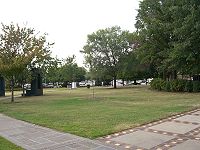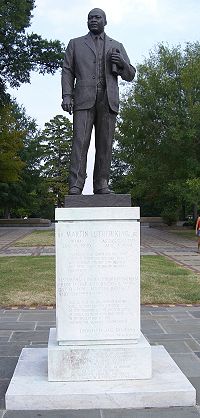
Kelly Ingram Park
Encyclopedia

Park
A park is a protected area, in its natural or semi-natural state, or planted, and set aside for human recreation and enjoyment, or for the protection of wildlife or natural habitats. It may consist of rocks, soil, water, flora and fauna and grass areas. Many parks are legally protected by...
located in Birmingham, Alabama
Birmingham, Alabama
Birmingham is the largest city in Alabama. The city is the county seat of Jefferson County. According to the 2010 United States Census, Birmingham had a population of 212,237. The Birmingham-Hoover Metropolitan Area, in estimate by the U.S...
. It is bounded by 16th and 17th Streets and 5th and 6th Avenues North in the Birmingham Civil Rights District
Birmingham Civil Rights District
The Birmingham Civil Rights District is an area of downtown Birmingham, Alabama where several significant events in the American Civil Rights Movement of the 1950s and 1960s took place...
. The park, just outside the doors of the 16th Street Baptist Church
16th Street Baptist Church
Sixteenth Street Baptist Church is a Baptist church in Birmingham, Alabama which is frequented predominately by African Americans. In September 1963, it was the target of the racially motivated 16th Street Baptist Church bombing that killed four girls in the midst of the American Civil Rights...
, served as a central staging ground for large-scale demonstrations during the American Civil Rights Movement of the 1960s.
Reverends Martin Luther King, Jr.
Martin Luther King, Jr.
Martin Luther King, Jr. was an American clergyman, activist, and prominent leader in the African-American Civil Rights Movement. He is best known for being an iconic figure in the advancement of civil rights in the United States and around the world, using nonviolent methods following the...
and Fred Shuttlesworth
Fred Shuttlesworth
Reverend Fred Shuttlesworth, born Freddie Lee Robinson, was a U.S. civil rights activist who led the fight against segregation and other forms of racism as a minister in Birmingham, Alabama...
of the Southern Christian Leadership Conference
Southern Christian Leadership Conference
The Southern Christian Leadership Conference is an African-American civil rights organization. SCLC was closely associated with its first president, Dr. Martin Luther King, Jr...
directed the organized boycotts and protests of 1963 which centered on Kelly Ingram Park. It was here, during the first week of May 1963, that Birmingham police and firemen, under orders from Public Safety Commissioner Eugene "Bull" Connor
Bull Connor
Theophilus Eugene "Bull" Connor was the Commissioner of Public Safety for the city of Birmingham, Alabama, during the American Civil Rights Movement...
, confronted demonstrators, many of them children, first with mass arrests and then with police dogs and firehoses. Images from those confrontations, broadcast nationwide, spurred a public outcry which turned the nation's attention to the struggle for racial equality. The demonstrations in Birmingham brought city leaders to agree to an end of public segregation. In addition, they helped ensure the passage of the Civil Rights Act of 1964
Civil Rights Act of 1964
The Civil Rights Act of 1964 was a landmark piece of legislation in the United States that outlawed major forms of discrimination against African Americans and women, including racial segregation...
and Civil Rights laws.
The park was named in 1932 for local firefighter Osmond Kelly Ingram, who was the first sailor in the United States Navy
United States Navy
The United States Navy is the naval warfare service branch of the United States Armed Forces and one of the seven uniformed services of the United States. The U.S. Navy is the largest in the world; its battle fleet tonnage is greater than that of the next 13 largest navies combined. The U.S...
to be killed in World War I
World War I
World War I , which was predominantly called the World War or the Great War from its occurrence until 1939, and the First World War or World War I thereafter, was a major war centred in Europe that began on 28 July 1914 and lasted until 11 November 1918...
. In 1992 it was completely renovated and rededicated as "A Place of Revolution and Reconciliation" to coincide with the opening of the Birmingham Civil Rights Institute
Birmingham Civil Rights Institute
Birmingham Civil Rights Institute is a large interpretive museum and research center in Birmingham, Alabama that depicts the struggles of the American Civil Rights Movement in the 1950s and 1960s...
, an interpretive museum and research center, which adjoins the park to the west.

Arthur Shores
Arthur Davis Shores was an American civil rights attorney who was considered Alabama's "drum major for justice".-Education:...
, Julius Ellsberry
Julius Ellsberry
Julius Ellsberry was the first Alabamian killed in World War II, and one of the first Americans to die in the Pacific during World War II...
, and the "foot soldiers" and other "unsung heroes" of the movement.
The park hosts several local family festivals and cultural and entertainment events throughout the year. The Civil Rights Institute provides audio-tour guides for the park which feature remembrances by many of the figures directly involved in the confrontations. Urban Impact, Inc. also provides guided tours by appointment.

